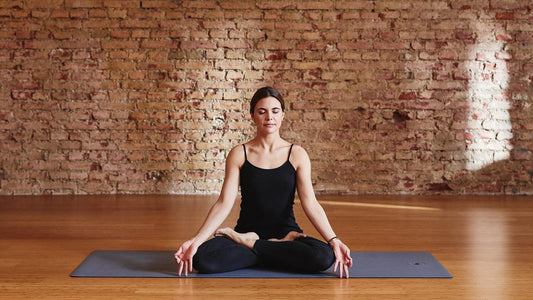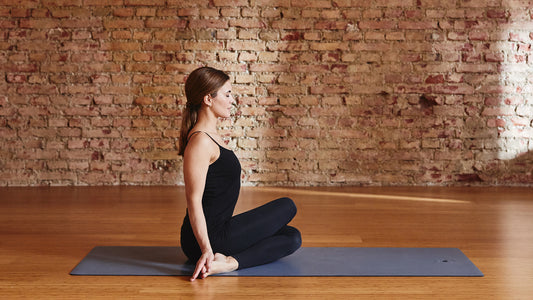
NEW In!
PURE-Matte Light TaupeShopping cart
Your shopping basket is empty
Yoga

Meditation
Sets & Bundles
If you are into modern spirituality, Kundalini Yoga is the right choice for you. The aim of Kundalini is to awaken the Kundalini energy through kriyas, breathing and meditation. Here, is where you can find out what these terms actually mean and which mantras, meditations and exercises you can use to learn Kundalini Yoga as a beginner.

The focus of this style of yoga is Kundalini, the primordial energy. In Kundalini teachings, this energy is symbolised as a sleeping snake that rests curled up at the bottom of the spine. Through the techniques and purification exercises (kriyas) learned in Kundalini Yoga, it is to be systematically awakened and rise with the help of the energy channels. Gradually it travels up through the seven chakras (energy centres) through the body. Once the kundalini energy is released and rises to the highest chakra, it leads to enlightenment.
The mantra "Sat Nam" plays a special role in Kundalini Yoga. Sat Nam is Sanskrit and translates as "truth" or "true identity".
Kundalini Yoga is a yoga of the highest order.
So Kundalini Yoga is not a style of yoga aimed at fitness. Of course, you also do asanas here, but the basic attitude is more important than the movement. A Kundalini Yoga session consists of a fixed series of pranayama (breathing exercises), asanas, meditation and mantras. Such a series is called a kriya.
The spiritual level is indispensable in Kundalini Yoga. Each Kundalini practice targets a specific area: for example, there are yoga sessions on different topics such as stress, anxiety and inner wealth. This is because a different series of exercises is used depending on which chakra is to be addressed.
The core of the meditation is usually "sat nam". By concentrating on this syllable or also on the modification "sa-ta-na-ma" (birth - life - death - rebirth), everything we have learned and experienced in society is to be removed layer by layer.
In Kundalini Yoga, the pranayama breathing exercises usually come before the individual practice sequences. An essential component of this is the fire breath, Kapalabhati: it is meant to take thoughts out of the present, help release Kundalini energy and prepare the mind for meditation.
The fire breath, Kapalabhati, is an essential part of Kundalini Yoga.
You may already be familiar with the fire breath from other styles of yoga. You exhale very forcefully through your nose and pull in your belly. The inhalation, on the other hand, is very short and only reflexive. Incidentally, this breathing technique is so-called because it makes you feel warm very quickly.
The practical thing about Kundalini Yoga is that you don't need years of yoga experience to practise this style of Yoga. A little prior knowledge does not hurt, but the willingness to engage with your spiritual aspect is more important. You should be aware that some of the asanas are held much longer than in Hatha Yoga, for example.
This style usually commences with breathing exercises. In addition to the fire breath described above, another common pranayama practice is to hold the right nostril closed with the thumb of your right hand and breathe deeply only through the left. Hold your breath for a moment and then close the left nostril so that you exhale through the right one for a long time. Pull your belly button towards your spine. You can do this exercise alone for up to half an hour!
In prone position, grasp both ankles. Inhaling lift your thighs and chest off the floor and make yourself round. In Kundalini Yoga, remain in this position for up to two minutes. Finally, release from the bow as you exhale.
Lying on your back with your arms beside your body, inhale while pulling your left knee towards your chest. At the same time stretch the right arm above the head. As you exhale, put your leg and arm back down and switch to the other side. Continue this alternation in rhythm with your breath for up to three minutes.
There are very many meditation variations in Kundalini Yoga. One classic is sat-nam meditation: you sit cross-legged (or lotus) and bring your palms together in front of your chest, the heart chakra. Sing or hum "sat" and "nam" while breathing, whereby the syllable "sat" should be clearly longer. If you can keep up this rhythm for several minutes, you will feel calmer due to the monotonous sound and the vibrations in your throat and will be able to concentrate better afterwards.
Whoever is open to spiritual practices and is looking for a gentle, especially meditative style of yoga can quickly recharge their batteries and gain a new body awareness with Kundalini Yoga.

Meditating - what does it actually do? Skeptics often ask this question, because at first glance meditation seems to be nothing more than "just si...
Continue reading
Alongside various styles of yoga, meditation has been a common relaxation practice in our society for some time. Many people swear by the so-called...
Continue reading